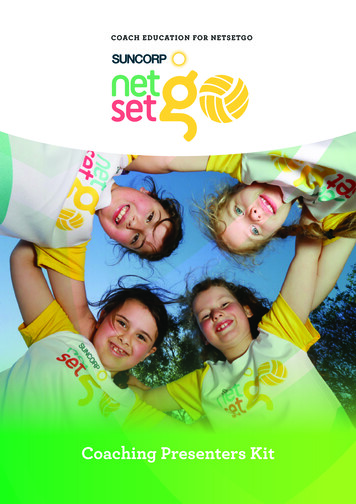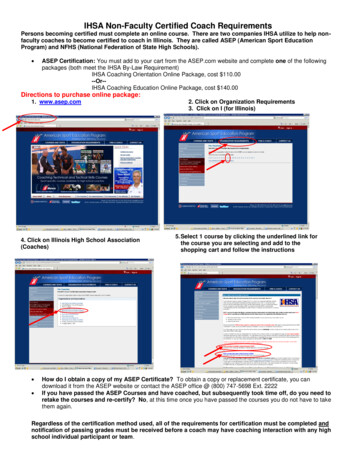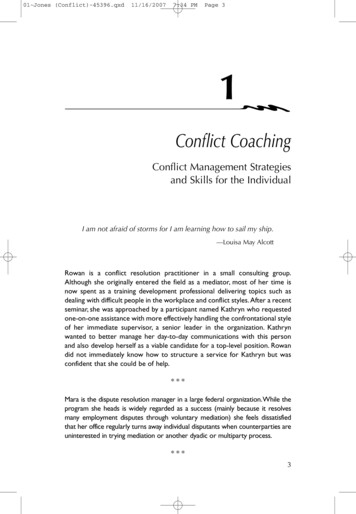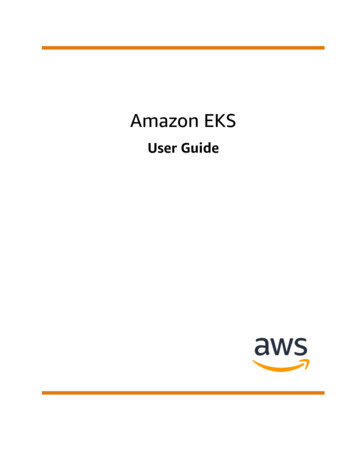
Transcription
COACH EDU CATION FOR NETSETGOCoaching Presenters Kit
WORKSHOP REQUIREMENTSPresenter Requirements Netball Australia Presenter’s Kit – NetSetGO Coaching Workshop Netball Australia Participant Workbook – NetSetGO Coaching Workshop Netball Australia Foundation Coaching Manual Australian Sports Commission, Beginning Coaching Manual (Fourth Edition) Whistle (Presenters to use own whistle) Computer for PowerPoint Presentation – as available Overhead or Data Projector for Overhead Transparencies – as available Flip Charts – as availableCoordinator Organisation Registration attendance sheets and participant details Stick on labels for participant’s names Tea/Coffee facilities Access to changing rooms and toilets Access to First Aid Kit, ice and phone for emergenciesLecture Room Requirements The theory area with the required number of chairs and tables should be close to the practical activity area to ensuremaximum learning time Flip Charts, overhead or data projector (an extension lead and power board may also be required) Whiteboard, non-permanent markers and eraserPractical Session Requirements Full size netball court or suitable safe area for the number of participants Goalposts Netballs (minimum of one ball per two participants) NetSetGO equipment kit Ball pumpEach Participant to Receive Netball Australia Outline – NetSetGO Coaching Workshop Netball Australia Participant Workbook – NetSetGO Coaching WorkshopEach Participant Should Bring to the Course Writing material Suitable training attire for practical activity sessions Suitable footwear for outdoor or indoor training surfaces Change of clothes/towel Sun protection, sunscreen and hat Water bottle and adequate refreshmentsNetSetGO – Coaching Presenters’ Kit2
PRESENTER RESPONSIBILITIESThe key components to a successful coaching course are: Good preparation and organisation. The quality of the delivery strategies. The ability of the participants to apply and implement the information. Creating a fun, enjoyable and appropriate learning environment.As a presenter you are expected to conduct the NetSetGO Coaching Workshop to a standard which satisfies NetballAustralia. The standard of the course will be influenced by a combination of the above components, in particular yourinstructional sessions, communication skills and rapport with participants.PreparationEnsure the necessary preparations for the course are undertaken, including:Liaison with course Co-ordinator to confirm: Workshop schedule/outline. Workshop venue and access. Participant numbers and background information (if known). Provisions for breaks and refreshments. Weather contingencies. Availability of required resources and equipment for the course.Note: Check that all equipment is in working order prior to the course and that arrangements have been made to accessfacilities and equipmentOrganisation Arrive at the venue with sufficient time to check the room set up and with time to re-arrange if necessary. Turn on lights, fans, open windows or turn on air-conditioner/heaters, as required. Set up laptop/projector or overhead projector and check the clarity of the image. Set up whiteboard, check non-permanent markers and eraser. Confirm arrangements. Ensure access to change rooms, open toilets etc if necessary. Set-up an area for participant’s to check-in on arrival and collect resources. Welcome participants as they arrive and assist co-ordinator to provide name tags.NetSetGO – Coaching Presenters’ Kit3
WORKSHOP OVERVIEW, DURATION AND OBJECTIVESWorkshop OverviewThe NetSetGO Workshop is intended to provide introductory information for coaches of NetSetGO There are noassessment or competency requirements for this Workshop.This course can be formalised into the Foundation Coaching Accreditation once the coach completes the on-lineBeginning General Principles and the Practical Assessment from the Foundation Coaching Course.Workshop DurationThe NetSetGO Workshop can be tailored to the needs of the participant group and time available. The Workshop has beendeveloped as a 2.25 hour program. If further time is available it is recommended that this be allocated to trialling activitiesdirectly from the NetSetGO lesson plans.Workshop sessionTime allocationPresentation methodsIntroduction10 minutesPresenter presentationJunior development45 minutesPresenter presentationPractical coachingTeaching of netball skills55 minutesPresenter presentationPractical coachingNetSetGO Competition netball20 minutesPractical coachingPresenter presentationConclusion/evaluation5 minutesPresenter presentationParticipant evaluationWorkshop Objectives Identify the roles of the coach. Understand the role of NetSetGO and its place in the player development pathway. Understand the benefits of using a game sense approach to teach game concepts. Understand the importance of effective group management skills to maximise opportunities for successful participation. Identify the elements of a training session and implement good coaching practices to reduce risk. Understand how to safely teach the basic skills and game concepts of netball. Identify skill faults and correct technique for the basic skills of netball.NetSetGO – Coaching Presenters’ Kit4
INTRODUCTIONPresenter MethodsPresenter presentationContentPresenter welcome and introduction. Brief presenter introduction.– Outline presenting background/education.– Coaching/playing/umpiring experiences. Ensure all participants have received the participant resources. Briefly outline workshop schedule and objectives. Outline general house keeping issues, as necessary.The following information should be used as an introduction. It is provided in the participant workbook.The Role of the CoachCoaches play an important role not only in the sporting life, but also the everyday life of the participants they coach.Coaches have the potential to influence not only the development of sport-specific skills and sporting performance, butalso the participant’s development as a person and their approach to other aspects of their life. While at times it can bechallenging, coaching can also be an immensely satisfying role.A sport like netball can provide a very powerful and positive influence on young people. Not only can it provideopportunities for enjoyment and achievement, it can also develop valuable qualities such as self-esteem, leadershipand teamwork. The extent to which these positive effects occur depends on the commitment of the coach in their role.Coaches of junior players are first and foremost teachers and role models. Many players always remember their first coach.The Inclusive CoachBeing an inclusive coach is a fundamental requirement for being a good coach. Being inclusive means adapting andmodifying coaching practices and activities to ensure that every participant – regardless of age, gender, ability level,disability and ethnic background – is included. Good coaches adapt and modify aspects of their coaching and create anenvironment that caters for individual needs and allows everyone to take part. The onus of inclusion rests with the coach.NetSetGO – Coaching Presenters’ Kit5
JUNIOR PLAYER DEVELOPMENTReferences ASC Beginning Coaching Manual, pages 121-125 and 111-120. Foundation Coaching Manual – Chapter 2 Junior Development, Chapter 4 Warm-up and Cool down and Chapter 7.Modified GamesPresenter Methods Presenter presentation. Practical coaching.CONTENTNetSetGOBeginners need simple and limited cues regarding technique and a lot of opportunity for practice. The temptation toteach too much too soon results in ‘over coaching’ and denies participants opportunities to explore and consolidate skills.NetSetGO provides developmental pathways and allows players of all abilities to participate enjoy and contribute.A fun environment includes elements such as positive feedback, feelings of identity, belonging, co-operation, achievement,friendship, respect, fair play and responsibility. The support of the coach is pivotal to achieving these goals.How would you respond to the concerns of the parent in the following scenario?Prior to the start of the NetSetGO program at your local association you have been approached by a parent concernedthat her 8-year-old daughter would not benefit from participating in the NetSetGO program. She is a former State playerand never played NetSetGO She feels her daughter needs the challenge of learning the ‘correct’ Netball skills and rulesunder full competition.The parent is considering withdrawing her daughter from the NetSetGO program and waiting for two years before reenrolling her in the Netball program.Group discussion of responses – scenario response guidelinesNetSetGO allows children to learn and develop their skills in a series of fun activities and minor games, which they can thenapply in a game situation. NetSetGO provides children with the best possible learning environment and enables them todevelop a positive introduction to Netball, ensuring enjoyment and continued participation within the sport.The focus of NetSetGO is on fun and enjoyment, introducing challenges and skills in line with the physical, cognitive, socialand emotional development of the child.Ensure the parent understands that it is the rules and umpiring that has been modified, not the skills and techniques.Encourage the parent to attend the NetSetGO sessions to observe the sequential skill development. Consider involving theparent in the teaching of modified games and skills.The following information is provided in the Participant Workbook to assist the participants in responding to theabove scenario.NetSetGO – Coaching Presenters’ Kit6
NetSetGO NET TIER (FOR 5-6 YEAR OLDS) – netsetgo.asn.auNetSetGO Net Tier is a play-based motor skills program. The emphasis is on the acquisition of basic motor skills, in afun environment of games and activities. The length of the NetSetGO Net Tier program can be run between 8-10 weeks,although this is flexible depending on school, association and individual needs.Children join the program as individuals, not as teams and the emphasis is on participation, developing skills and havingfun. Refinement of the skills and their application to the game will be introduced when they reach the next stage –NetSetGO Set Tier (for 8-10 year olds).Research from a number of areas has highlighted the need for young Australians to develop motor skills both in and outof the school environment. Provision of an age appropriate, staged progression for Netball participation is an essentialelement in developing confident and skilled participants. NetSetGO Net Tier has an important role to play in preparingyoung children for involvement in Netball, ensuring life-long participation.The introduction of dance activities to NetSetGO Net Tier provides a fun way to develop a range of fundamental motor skillsthat are used in netball including twisting, turning, bending, leaping, dodging, skipping and sliding.Children who do not develop these basic fundamental motors skills are more likely to experience frustration and difficultyin learning advanced skills which reduces their enjoyment. Dancing is a great way to engage young children who are juststarting netball in motor skill activities.NetSetGO Net Tier provides: A program appropriate to the age and ability of the participants. All children with the opportunity to participate and experience a feeling of success from their participation. An opportunity for children to develop and expand their motor skills in a non-competitive environment. Participants with better basic motor skills when they enter NetSetGO Set Tier. Opportunities for parents to be involved.NetSetGO Net Tier is a flexible program and can be delivered within an Association, Club or School.The guidelines of NetSetGO Net Tier state: Players are arranged into small groups with a coach. Players are put through a 30-45 minute fun training session. Focus is on fundamental motor skills development, using netball activities, minor games, dance and music. Modified equipment is used (size 4 netballs). There is no match play or competition.NetSetGO – Coaching Presenters’ Kit7
NETBALL AUSTRALIA – NetSetGO SET TIER (for 7-8 year olds) – netsetgo.asn.auThe NetSetGO Set Tier incorporates skills development and round robin modified match play with the emphasis on massparticipation and fun. It allows children to learn and develop their skills in a series of fun activities and minor games, whichthey can then apply in a game situation. NetSetGO Set Tier provides children with the best possible learning environmentand enables them to develop a positive introduction to Netball, ensuring enjoyment and continued participation within thesport.NetSetGO Set Tier provides: A program appropriate to the age and ability of the players. All children with the opportunity to participate and experience a feeling of success from their participation. An opportunity for children to play in a cooperative way and to develop their skills in a non-competitive environment. An environment where the emphasis is not on “win at all costs” but rather on the development of skills, the discovery ofnew ones and sharing the play with other team mates.NetSetGO Set Tier has been designed to meet the needs of children and gives them a chance to be successful and feelgood about themselves. Other sports that have taken a similar approach include Australian Football League (Auskick),Hockey (Hook in2 Hockey), Rugby League (Kids to Kangaroos), Rugby Union (Try Rugby), Cricket (Milo in2 Cricket) andBasketball (Aussie Hoops).The rules and equipment for NetSetGO Competition have been designed to align the game with the psychological andphysical capabilities of young children. The program has been developed under the guidelines of the Netball AustraliaJunior Sports Policy, which emphasizes “The introduction of children to organised competitive Netball should be gradualand is best achieved through minor games/activities and modified rules.”The NetSetGO Set Tier program is versatile and it can be delivered in Clubs, Associations or Schools.NetSetGO – Coaching Presenters’ Kit8
NETSETGO GO TIER (for 9-10 year olds) – netball.asn.auThe GO tier has been introduced to ensure a smooth transition for participants into Junior Netball. The modified rulesand equipment allow for participants to experience success while learning the correct technique and executing skills withgreater proficiency.NetSetGO GO Tier provides: A program where the participants are introduced to more netball-specific skills as well as refining their fundamentalmovement skills. Participants have a chance to enjoy practicing skills they learn and seeing their own improvement. Competitive elements, however the focus should not be on winning Each participant with equal court time and exposure to a variety of positions so they are gaining the full experienceon court.The rules are still modified in the GO tier as it is critical that children use sporting equipment that is matched to theirsize and age (ie smaller netball and shorter goal posts). Matching the right sized equipment, will not only promote thedevelopment and refinement of the children’s sporting skills but also reduce the likelihood of injury.NetSetGO – Coaching Presenters’ Kit9
DEVELOPING SPORTS SKILLSPrior to conducting the practical session ensure coaches understand the game sense approach.Game SenseThe emphasis with a game sense approach is on the participants making decisions within the game, rather than thecoach telling the participants where to run and where to pass. The coach becomes a facilitator, creating situations whereparticipants have the opportunity to respond to challenges through activity and solve problems. The participants ‘learn fromthe game’.To achieve progressions within a game. Use games that allow time to make decisions early in the session. Progress to games that reduce the time available forreaction and decision making. When first introducing a tactical problem choose techniques that the participants can easily control (for example; type ofpass to be used). Progress to more difficult techniques when the tactical problem has been accomplished. Progress from a relatively closed environment to a more open environment. For example: Stationary targets moving targets Few rules many rules One opponent more than one opponent One team mate more than one team mate Separate court areas shared space One simple movement combinations of movementsPractical SessionThe following practical session is designed to give examples of how to present, design and modify games and activities. Itis not expected that presenters try to cover all the activities outlined. It is intended to demonstrate best coaching practiceusing an example of 2-3 activities.The presenter should demonstrate the key concepts of group management. Engaging the participant (use of voice and expressions, eye contact, signal for attention, ask questions, praise andfeedback and quality instructions). Establishing formations and routines (formations, safety, providing challenge). Catering for individual differences (inclusion, specific groups).Using the practical examples outlined on page 114 of the ASC Beginning Coaching Manual the presenter shoulddemonstrate how to set up and move efficiently between activities and different group formations. This should beintegrated into the practical presentation and should also include the positioning of the coach in relation to thegroup formation.Whilst the participants will act as players during this practical component it is important to ensure there is an adequatepresenter de-brief of the practical activities and how to establish routines and formations. The presenter should provideopportunities for participants to question and clarify any aspect of the session.The following table has been developed as a guide to assist the participants and presenter to determine the mostappropriate stage of development for each activity. Encourage participants to discuss how they could modify the activity tocater for different ability and age groupings.NetSetGO – Coaching Presenters’ Kit10
CHASING AND AVOIDANCE GAMESThe following chasing and avoidance games can be adapted to cater for the individual abilities and needs of the group.The activities can be used as part of a warm-up or as a concluding activity at the end of a training session. Refer to theNetball Coaching Foundation Accreditation Manual for additional warm-up activities and games.Games and activitiesFormatAppropriate stage of development5-6 years7-8 years9-10 yearsFox and GeeseSmall group Rats and RabbitsGroup/Partner TailsGroup/Partner FOX AND GEESE Players4 per group Playing areaOne third of netball court (area appropriate to numbers) EquipmentNone3 players join hands to form a circle, with the extra player the nominated tagger or ‘fox’. The fox tries to tag the player inthe circle designated the ‘goose’. The players keep the circle intact and aim to move around and reposition to protect thegoose from being caught by the fox. The fox needs to make quick changes of direction to move around the group and tryto catch the goose. The fox can not push through or go under the arms of the players protecting the goose.After a designated time frame (for example; 30 seconds) or after the tagging the nominated player the tagger joins thecircle and the next player becomes the tagger on the outside of the circle.Variations TRAIN TAG The formation changes to 3 players in a single file, with each player holding the waist of the player in frontof them (diagram B). The nominated tagger starts facing the line. The tagger aims to move around the front player andtries to tag the back player. After a designated time frame or after the tagging the back player the tagger moves to theend of train and the front player becomes the next tagger.NetSetGO – Coaching Presenters’ Kit11
RATS AND RABBITS PlayersPartners/group activity Playing areaOne third of netball court (area appropriate to numbers) EquipmentNoneRatsRabbitsXOXOXOXOXOXOXO Players set up in two single file lines next to a partner who is standing one metre away.One line of players is designated the ‘rats’ while the other line is the ‘rabbits’. On the call of ‘rats’ or ‘rabbits’ by the coachthe player aims to sprint to the nominated ‘safety’ line before their partner can catch them.The activity can be set up in the centre third with players aiming to reach the transverse line before their partner catchesthem. Ensure the safety of the players by using lines with adequate run off. Players can keep a tally of scores; receivingone point if they catch their partner or one point if they reach the line before they are caught.Variations ‘CRUSTS AND CRUMBS’, ‘BRATS AND BROWNIES’ Different similar sounding words can be substituted instead ofrats and rabbits.NetSetGO – Coaching Presenters’ Kit12
TAILS PlayersPartners/group activity Playing areaOne third of netball court (area appropriate to numbers) EquipmentColoured bibs or tagsThe bib or coloured tag is tucked into the back of a player’s shorts/skirt with half the bib hanging free as a ‘tail’. There are anumber of tail variations however each game involves the player with the tail trying to evade having their tail taken. Ensureplaying area is clearly defined and reinforce the importance of players looking out for other players also moving within the area.Variations PARTNER TAILS The player with a tail is chased by their partner in the designated area. TWO PLAYER TAILS Both players have a tail and attempt to grab their partner’s tail while protecting their own tail frombeing taken. SPLIT GROUP TAILS Half the group receives one colour tail while the other half has a different colour. The playersmove around in the same area however, the players can only grab the same colour tail as their own. TEAM TAILS All players have the same colour tails and aim to grab as many tails as possible while protecting their owntail from being taken. These activities can be adapted to include other locomotion skills such as jumping, leaping, skipping and dodging.NetSetGO – Coaching Presenters’ Kit13
INVASION GAMESThe following modified games can be applied using a game sense approach.Games and activitiesFormatAppropriate stage of development5-6 years7-8 years9-10 yearsNetball TagGroup Number NetballGroup Progressive Keepings OffGroup Corner BallGroup Space InvadersGroup PROGRESSIVE KEEPINGS OFF Players2 groups x 3 players Playing areaOne third netball court (area appropriate to numbers) Equipment1 ball, bibs or tags (optional)Two even teams (bibs or tags may be used to distinguish teams).The 3 attacking players aim to use a variety of movements within a defined area to evade an opposition player to make10 consecutive passes. Begin initially with 1 defender (3 V 1). If the attacking team successfully makes 10 consecutivepasses within the defined space then they progress to 2 defenders (3 V 2). The aim is to gain 10 consecutive passes andto progress to 3 defenders (3 V 3).If the ball is dropped or intercepted by the defending team they gain possession of the ball. Each team must buildprogressively from 1 through 2 then 3 defenders. The winning team is the first to make 10 consecutive passes against full3 on 3 defence. The attacking players may use any movement and passing variations to receive and pass the ball.Variations VARY ATTACKING SKILLS Depending on the skill level of the players the attacking skills may include a straight lead,dodge, double dodge, change of direction, lead and drop, roll off or front cut. VARY DEFENDING SKILLS Depending upon the skill level of the players the defending skills may include one on oneor area defence.NetSetGO – Coaching Presenters’ Kit14
CORNER BALL Players2 groups x 5 players Playing areaOne third netball court (area appropriate to numbers) Equipment1 ball, bibs or tags (optional)Two even teams (bibs or tags should be used to distinguish teams).This is an extension of the Progressive Keepings Off Game. In Progressive Keepings Off the 3 attacking players aim to usea variety of movements within a defined area to evade an opposition player to make 10 consecutive passes. Begin initiallywith 1 defender (3 V 1). If the attacking team successfully makes 10 consecutive passes within the defined space thenthey progress to 2 defenders (3 V 2). The aim is to gain 10 consecutive passes and to progress to 3 defenders (3 V 3).If the ball is dropped or intercepted by the defending team they gain possession of the ball. Each team must buildprogressively from 1 through 2 then 3 defenders. The winning team is the first to make 10 consecutive passes against full3-on-3 defence. The attacking players may use any movement and passing variations to receive and pass the ball.Corner BallExtend the game to 5 players on each team with one player in each corner of the playing space. The attacking team aim topass the ball from their corner player to the opposite corner player via the 3 attacking players who are able to move in theone third. The defending team also has 3 defending players able to move in the one third. If the defending team intercept apass they roll the ball to their nearest corner player then they become the attacking team.Variations VARY ATTACKING SKILLS Depending on the skill level of the players the attacking skills may include a straight lead,dodge, double dodge, change of direction, lead and drop, roll off or front cut. VARY DEFENDING SKILLS Depending upon the skill level of the players the defending skills may include one on oneor area defence.NetSetGO – Coaching Presenters’ Kit15
SPACE INVADERS Players2 groups x 3 players Playing areaOne third netball court (area appropriate to numbers) Equipment1 ball, bibs or tags (optional)Formation as per diagram. One third of the netball court is further divided into 3 even sections. Two even teams (bibs ortags may be used to distinguish teams).The defenders are restricted to a defined area of the court as outlined in the diagram. For example; one third of the netballcourt is further divided into 3 even sections with one defender in each section. The 3 attacking players aim to use a varietyof movements within the defined space to evade an opposition player. The attacking team must receive at least one passin each section and all 3 attacking players must receive the ball at least once. For the attacking team to score one pointthey need to pass the ball without it being dropped or intercepted from the starting sideline across to the opposite sideline.The attacking team has 5 attempts to gain as many points as possible. Each time the ball is dropped or intercepted theybegin again from the nearest sideline. Alternatively if the ball is dropped or intercepted the defending team scores onepoint. The defenders and attackers rotate positions after 5 attacking attempts.Variations PROGRESSIVE SPACE INVADERS The defenders begin in their respective defending areas. Once the ball has beenpassed in their section they can ‘drop back’ into the next defending area to assist the next defender. The pattern can berestricted to only two defending players in each section or increased to all 3 defenders moving into the last defendingarea to try to intercept the pass. The attacking team has 5 attempts to gain as many points as possible. Each time theball is dropped or intercepted they must begin again from the nearest sideline. VARY THE NUMBER OF PASSES Vary the number of passes the attacking team must make in each section beforeprogressing to the next area. For example, three passes in each area. VARY THE SIZE OF THE PLAYING AREA For example; two thirds of the netball court. VARY ATTACKING SKILLS Depending on the skill level of the players the attacking skills may include a straight lead,dodge, double dodge, change of direction, lead and drop, roll off or front cut. VARY DEFENDING SKILLS Depending upon the skill level of the players the defending skills may include one on oneor area defence.NetSetGO – Coaching Presenters’ Kit16
NETBALL TAG Players6-14 players (variable) Playing areaOne third netball court (area appropriate to numbers) Equipment1 ball, bibs or tagsAll players begin in one third of the netball court.For a group of 12 players designate 3 taggers who wear a bib or tag. The aim is for the taggers to pass the ball within thedefined space in an attempt to get close enough to reach with the ball and tag one of the free players. Ensure the balldoes not leave the taggers hands and is not thrown at the player. In this variation all footwork rules apply to the player withthe ball. All other players are able to move freely in the defined space.Once a player is tagged this player quickly puts on a bib or tag to join the tagging group. With each successive playertagged the number of runners diminishes increasing the difficulty to evade being tagged. Play continues until there is onlyone free player remaining.Variations STOP START NETBALL TAG Once a player is tagged the play stops while this player quickly puts on a bib or tag tojoin the tagging group. The stop in play builds in a brief rest break to cater for varying fitness levels. COUNTING NETBALL TAG The tagging group aims to make as many tags as possible in a defined time. For example;3 tagging players count the number of tags they can make in 1 minute. Rotate tagging and running groups with eachseparate group aiming to make the greatest number of tags. RATIO OF TAGGING TO RUNNING PLAYERS The ratio of tagging players to running players can vary dependingupon the ability level and size of the group. NUMBER OF PASSES Vary the number of passes the attacking team must make before tagging a player. VARY NETBALL RULES TO BE APPLIED For example; change the time the ball can be held before passing or ta
NetSetGO - Coaching Presenters' Kit 6 JUNIOR PLAYER DEVELOPMENT References ASC Beginning Coaching Manual, pages 121-125 and 111-120. Foundation Coaching Manual - Chapter 2 Junior Development, Chapter 4 Warm-up and Cool down and Chapter 7. Modified Games Presenter Methods Presenter presentation. Practical coaching. CONTENT .










